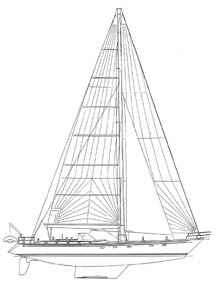Sonny
Bluewater cruiserr
Clearly a major contribution to any boat's looks is the yard. Ugly boats can be built by insensitive builders working with beautiful drawings. Conversely, beautiful boats can be built by a skilled and aesthetically sensitive yard from not-so-beautiful drawings. If you have any doubts as to the Brooklin yard's abilities take a look at the Joel White W-class boat Wild Horses. It's a masterpiece.
While short ends may make sense to a VPP run intended to get the most knots out of a given LOA, short ends are seldom pretty. Short-ended boats can look handsome, brutish, powerful and businesslike, but I don't think I've ever seen one I would call beautiful. Dieter has given Sonny plenty of bow overhang and a generous amount of stern overhang. In fact, working with an LOA of 69 feet, 10 inches, the DWL is only 58 feet. That's almost 12 feet devoted to overhangs. Overhang forward can work well for a cruising boat. It gives you greater deck area forward, keeps the anchor well away from the stem and makes for a drier boat in a seaway.
Dieter's sheerline for Sonny is strong in its amount of sweep and yet gentle enough not to be too detracting. Beam is modest at 16 feet, 6 inches for an L/B of 4.23. The D/L is on the low end of "medium" at 175.6. The 8-foot draft is complimented by a large wing starting at around the 30-percent position on the tip chord.
Obviously with 70 feet to work with you can do a flush deck design without exaggerating the freeboard. Flush deck designs tend to highlight the sheerline. In this design there is very little that is going on to distract your eye from the sweep of the sheer. Looking at the sailplan you can see the small structure that provides the height for the cockpit coamings and the companionway. This blends in well with the hull. The lines of this structure are very simple. The rig shows triple, swept spreaders and in-boom furling for the mainsail. There is provision made for a self-tacking staysail for heavy air, and with a flush deck forward, there is nothing to stop the self-tacking track from going as far outboard as needed to give the staysail a good shape on a close reach. Actually I'd like to see this one even wider to give more sheeting options. There is a clew board on the staysail to allow for varying the lead angle. Winches are Harken hydraulic. Better get your thumb in shape. Pushing those buttons can be grueling.
This is a wonderful and comfortable layout, although I'm not wild about circular dinettes. They look great on the drawing, but I prefer some corners to wedge into. Note the huge "navigatorium" on this layout. I like the berth arrangement aft. There is a double to starboard and a single berth to port. The other staterooms forward have upper and lower single berths.
If Mr. Phelps calls you and asks you to go cruising with him on Sonny I suggest you accept.

Comments